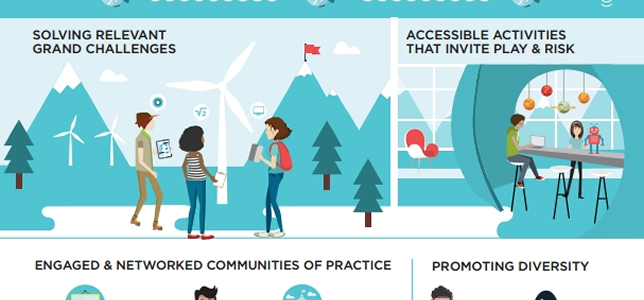Collaboration
STEM is all about collaboration. Collaborative learning experiences where students and teachers are working alongside one another toward solving real-world, grand problems that invite both play and risk (US Department of Education). So, what exactly is collaboration?

Collaboration is “when members of an inclusive learning community work together as equals to assist students to succeed in the classroom” (Powell). Friend and Cook (1992, pp. 6-28) explain that collaboration has six defining characteristics: (a) collaboration is voluntary, (b) collaboration requires parity among participants, (c) collaboration is based on mutual goals, (d) collaboration depends on shared responsibility for participation and decision making, (e) individuals who collaborate share their resources, and (f) individuals who collaborate share accountability for outcomes.
What is collaboration?
Although this is a fine and detailed definition, sometimes it is important to simplify an often well-known, but misunderstood concept.

Yes, true collaboration needs to be voluntary (especially in STEM classrooms), with mutual goals and a shared responsibility and accountability, but at its heart, collaboration is when people (teachers, students, administration) work together toward a shared goal. This applies to students in a classroom and leadership within a school district or building. True collaboration require an interdependence “characterized by trust, norms of give-and-take, shared responsibilities, consensus-building and conflict resolution mechanisms, shared power and authority and shared information and decision-making systems” (Anderson-Butcher, Lawson, Bean, Boone, Kwiatkowski, et al., 2004, p. 2).
Why is collaboration important?
Collaboration is such an important skill, both for students and adults, because we live in a world of design-thinking. Although human beings are social creatures, collaboration isn’t necessarily easy for everyone; however, true innovation comes from being a part of a learning community where there is time to think critically, and re-energize our love of learning. Whereas some teachers are used to working in isolation because they are a content specialist, effective schools and organizations establish a culture of collaboration where students are the responsibility of all teachers, not just one. Collaboration improves teacher efficacy, through professional development and learning opportunities, which in turn, improves student performance. Having a professional, innovative culture reduces teacher burn-out because teachers are willing to share with each other, support each other, and learn together.

How does one foster collaboration?
Fostering collaboration comes from a structured process for exchanging ideas and insights, content and curriculum, with colleagues. So, how does one design structures that support collaboration? Design principles and strategies for collaboration and collaborative leadership are numerous; however, here are the three I find most important: (a) environment, (b) structure, and (c) purpose. Creating an environment of trust is the first priority for anyone wanting to collaborate. The ability to compromise will be difficult for some; however, in order to obtain a common goal, teachers must be unified in a single purpose. Collaborative teachers must agree to this purpose before they can proceed. So, when designing a STEM lesson or learning experience, be sure to involve a healthy amount of collaboration. It is a skill vital to the success of all students.

 Next Post
Next Post